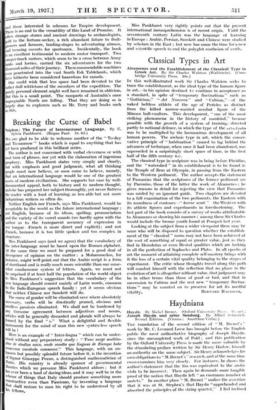Classical Types in Art
bridge University Press. 308.)
IN this well-illustrated work Sir Charles Walston seeks to trace the establishment, as the ideal type of the human figure
in art,—in his opinion destined to continue in acceptance as a standard, in spite of "temporary fluctuations" such as "Gothicism," " Art Nouveau" and "Cubism,"—of the naked beltless athlete of the age of Pericles as distinct from the kilted narrow-waisted acrobat figure of the
Minoan bull-vaulters. This development, " one of the most striking phenomena in the history of mankind," became possible with the growth of a system of training,' directed partly to national defence, in which the type of the salloka-yadat was to be multiplied by the harmonious development of all human powers. The archaic type in art, which the conser- vative principle of " habituation " caused to lag behind the advances of technique, when once it had been abandoned, was superseded in a surprisingly short space of time, in the first half of the fifth century B.c.
The classical type in sculpture was in being before Pheidias, and the "watershed " in its establishment is to be found in the Temple of Zeus at Olympia, in passing from the Eastern to the Western pediment. The author accepts the statement of Pausanias that the sculptures of the former pediment arc by Paeonius, those of the latter the work of Alcamenes ; he gives reasons in detail for rejecting the view that Pausanias was misled by an ignorant guide. Two chapters arc devoted to a full examination of the two pediments, the Eastern with its roundness of contours--" horror act& -the Western with its athlete figures and experiments in foreshortening. The last part of the book consists of a survey of works attributable to Alcamenes or showing his manner ; among these Sir Charles would include the bronze youth found at Pompeii last year.
Looking at the subject from a wider viewpoint there may be some who will be disposed to question whether the establish- ment of the " classical " norm may not have been achieved at the cost of something of equal or greater value, just as they find in Herodotus or even Hesiod qualities which arc lacking in all the perfection of Sophocles and Plato. In all epochs of art the moment of attaining complete self-mastery brings with it the loss of a certain vital quality belonging to the stages of experiment. The critic whose thoughts travel along this path will comfort himself with the reflection that no phase in the evolution of art is altogether without value, that judgment may be in other terms than those of good or bad, and that in succession to Cubism and the rest new " temporary fluctua- tions " may be counted on to preserve for art its needful






























































 Previous page
Previous page